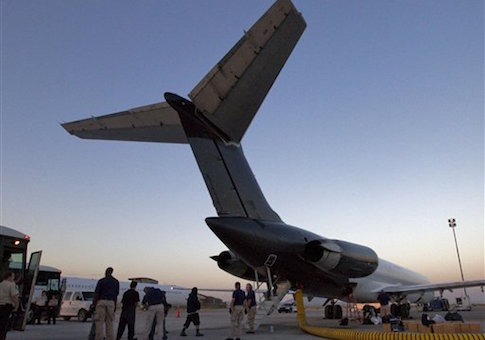Poor management practices at the Immigrations and Customs Enforcement (ICE) air program have potentially cost taxpayers $41.1 million by allowing for detainees to be transferred on nearly empty flights, according to a new audit.
The Department of Homeland Security’s (DHS) Office of Inspector General (OIG) also found that the agency’s database for tracking the transfer of detainees is riddled with errors, leaving ICE unsure of a detainees’ criminal history, gang affiliation, or even gender.
ICE Air uses charter and commercial flights to transfer detainees to foreign countries or within the United States. In many instances, the audit found, the flights are less than half full.
"Although ICE Air met its mission by transporting 930,435 detainees over a 3-1/2 year period, it could have used its resources more effectively," the audit said. "In fact, ICE Air may have missed opportunities to improve the program’s overall effectiveness even though it has identified some ways to reduce costs associated with detainee transportation."
"The lack of reliable data limits the ability of management to make informed decisions regarding how many planes it needs to transport the current level of detainees, whether it should revise the frequency of its flights, and how to improve operations overall," the OIG said.
"As a result, ICE Air operated charter flights with empty seats and could have realized cost savings of up to $41.1 million upon determining optimum flight capacity," they said.
The audit said that "special requests by the DHS Secretary and other mission needs such as the recent surge of unaccompanied children" have prevented ICE Air from providing efficient service.
The OIG found 299 flights between October 2010 and March 2014 that were less than 40 percent full, costing $11,983,026. Another 745 flights used less than 60 percent of the plane’s seats, costing $41,085,000. Overall, $116 million were spent on flights that used less than 80 percent of their capacity.
Each flight hour transferring detainees on charter planes costs taxpayers $8,419, "regardless of the number of passengers on the plane," the OIG said.
ICE Air tracks the information on detainees transported with its Alien
Repatriation Tracking System (ARTS). The audit found that data within the system is often incomplete or inaccurate.
For instance, "The data field ‘Sex,’ used to record gender, is not restricted to male or female, and contains numerous entries, such as the numbers 0, 30, and the word ‘none.’"
"The data field ‘Criminality’ was not restricted to specific entry choices and contains non-logical entries such as ‘#Ref!’" the audit said. "The field is blank for 20,798 detainees."
Information on a detainee’s status as a "Gang Member" also contains "non-logical numerical entries, such as ‘2’ or ‘3770701,’ for at least 3,000 detainees."
"The field is blank for 155,966 detainees," the audit said.
The database also did not have identification numbers or fingerprints for 190,243 transported detainees.
Furthermore, information on the destination for nearly 25,000 detainees was incorrect.
"There were 23,597 detainees listed as being ‘picked up’ or ‘dropped off’ at locations not on the charter flight route," the OIG said. "Specifically, there were 54 detainees recorded as removed to Nicaragua for one mission that included stops only in Louisiana, Texas, and Guatemala."
The audit blamed some of the problems of the flight program on a lack of trained employees and poor management.
ICE "did not provide the planning, management, and reporting tools needed to operate effectively, and it does not have a mechanism in place to obtain feedback on how well its processes are performing," the audit said. "[Enforcement and Removal Operations] ERO management has not developed a data management plan, assessed staffing and training needs, or implemented formal policies and procedures."
The majority of the 930,435 detainees transported between 2011 and 2014 were removed to their home country. Others were moved within the United States due to "lack of bed space, immigration proceedings, medical needs, security concerns, and other administrative reasons."
Most were flown to Central America, South America, and the Caribbean.
